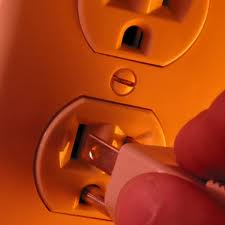| The rough-in inspection takes place when all branch circuit wiring and outlet boxes are installed and prior to any wiring being concealed by insulation, vapour barrier, drywall, etc.
As a minimum for the rough-in inspection the following shall be completed:
- all cable and all outlet boxes shall be installed and supported as per the Code,
- all bonding conductors shall be connected within all outlet boxes including provision of a bonding conductor for final connection to wiring devices such as receptacles,
- all required joints in the wiring at all outlet boxes shall be made up including provision of pigtails where required for final connection to wiring devices, and
- nail/screw protection plates shall be installed where required.
No wiring shall be concealed by installation of insulation or floor, wall, and ceiling materials until authorized by an electrical inspector.
For new installations the service inspection and the rough-in inspection are completed at the same time, or additional inspection fees may be applied.
Rule 2-004.
Ontario Electrical Safety Code 24th Edition/2009.
| Question |
| I understand the Code requires GFCI (ground fault circuit interrupter) protection of receptacles next to my kitchen sink. Can I install a 15 amp GFCI type receptacle at these outlets? |
| Answer |
| No. The Code requires either a 15 amp multi-wire circuit and 15 amp split receptacles or a 20 amp circuit and T-slot receptacles for kitchen counter outlets. A 15 amp rated GFCI receptacle cannot be installed in compliance with either of these requirements.
Code compliant GFCI protection of the split circuit and receptacle option can be achieved by installing a 2 pole 15 amp GFCI circuit breaker at the panelboard.
Code compliant GFCI protection for the 20 amp non-split circuit option can be achieved by either installing a 20 amp GFCI circuit breaker at the panelboard or by installing a T-slot GFCI type receptacle at the outlet.
Rules 26-700, 26-712, 26-722.
Ontario Electrical Safety Code 24th Edition/2009.
| Question |
| What is a service layout and how do I arrange to get one? |
| Answer |
| A service layout is obtained by contacting the Supply Authority (electric utility) that supplies power to your premises. Many supply authorities accept requests for service layouts on-line at their website or you can contact the supply authority by phone to make your request. Your electrical contractor can also look after this for you.
Most supply authorities require a service layout for any premises where electrical power has not been supplied previously, or for premises where the customer wishes to upgrade and/or relocate their existing electrical service. The service layout must be completed before any work is done to install or change a service.
A service layout is a sketch that is prepared by the supply authority together with the customer to determine the location of the service and meter, to determine what equipment and wiring the supply authority will need to supply and install and to determine what equipment and wiring the customer may need to install for connection to the supply authority.
| Question |
| What is a “final inspection” and when does it take place? |
| Answer |
| This inspection is done after the electrical installation is complete. This means that all receptacles, switches, cover plates, lighting fixtures and permanently connected appliances are in place and the panel directory has been completed. All unused openings in panel boards or junction and outlet boxes shall be filled with suitable fillers.
Where an appliance that is to be permanently connected is not yet on site, the cable shall be terminated in a junction box complete with a blank cover and the ends of the conductors shall be insulated with wire connectors or tape. Where permanent light fixtures are not yet on site, install temporary light fixtures or a blank cover on lighting outlet boxes.
The final inspection shall be requested as soon as possible after completion of the electrical installation.
Rule 2-004.
Ontario Electrical Safety Code 24th Edition/2009.
| Question |
| What is meant by the term “Type IC” when referring to recessed lighting fixtures? |
| Answer |
| The acronym “IC” means “insulation contact”. This marking on a recessed lighting fixture (also called a can light or a pot light) means they are tested and certified to be installed in direct contact with or blanketed with thermal insulation.
Another marking you may encounter is “Type IC, inherently protected”. The difference in the markings is the method of protection the fixture uses to prevent overheating.
NOTE: “Type NON-IC” fixtures can overheat dangerously and become a fire hazard when installed in contact with or blanketed with thermal insulation.
The manufacturer’s installation instructions shall also be followed in any installation.
Rule 30-906.
Ontario Electrical Safety Code 24th Edition/2009. |
|
|
|
|


Question: Re knob and tube and GFCI
GFCI protection may be acceptable to the Electrical Safety Authority and I have heard that this can be a cost effective remedy to replacing all the knob and tube wiring. While it may not be the ideal – is it worth considering?
Many thanks!
Yes it is acceptable to ESA for install GFI’s to protect ungrounded circuits as long as it can be shown that the knob and tube is in good shape and nothing has been added to it or the circuit has not been modified.
However, insurance companies may not accept it. Each company is different. Some will accept GFI or ungrounded 2 wire circuits but not for knob and tube.
I would challenge anyone to show me a knob and tube house that meets all the criteria. Knob and tube is very old and needs to be replaced in 99% of all cases.
Is your house currently knob and tube?